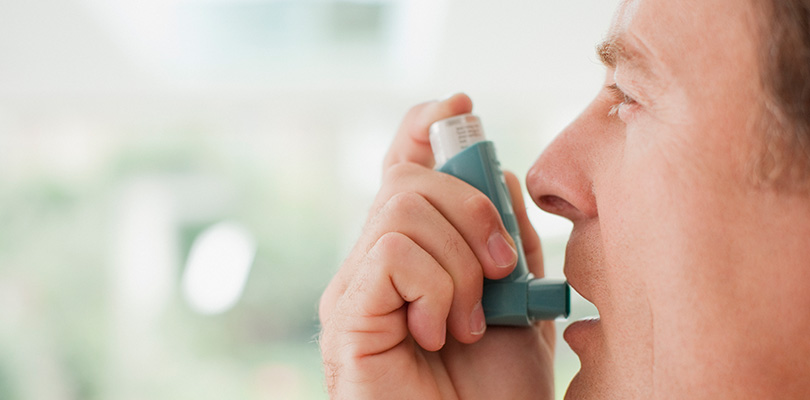What Is Salt Therapy for COPD?
Chronic obstructive pulmonary disease, also called COPD, is a long-term lung condition that involves damage to the small air sacs in the lungs. According to the Centers for Disease Control and Prevention, approximately 15 million people in the U.S. have a COPD diagnosis.
The damage to the air sacs causes increased mucus production, swelling, and constriction of the airways. The combination of changes to the airways causes symptoms, such as: wheezing, breathlessness, chest tightness, decreased oxygen levels, coughing and fatigue.
Currently, there is no cure for COPD, but treatments can help ease symptoms and slow the progression of the illness. Typical treatments include breathing medications, oxygen therapy and steroids. But some people also turn to alternative therapies, such as salt therapy for COPD.
What Is Salt Therapy and Can It Help COPD?
Although you may not have heard of salt therapy, it is not new. Salt therapy has been used in countries outside the U.S. for a long time.
Salt therapy is also called halotherapy and it is sometimes used to treat respiratory conditions, such as COPD. Some Eastern European countries have natural salt caves that have a climate and environment that is thought to potentially be beneficial for lung conditions.
Natural salt cave environments have moderate to high humidity, stable air temperatures and the presence of fine elements of sodium that give it the characteristics that may ease some lung disease symptoms.
Since most people do not live near a natural salt cave, salt therapy involves sitting in a room or chamber that mimics the environment of the cave while inhaling micronized dry salt.
How Does Salt Therapy Help COPD?
Proponents of salt therapy believe that it may have a role in treating lung conditions, such as COPD. There are different theories on how it may help. For instance, it is theorized that the salt particles may decrease inflammation that occurs with COPD. It may also kill pathogens that can contribute to lung infection.
Another possible benefit is it may thin or decrease mucus production. Inhaling the salt particles may draw water into the airway and thin the mucus, which makes it easier to cough up.
According to the International Journal of Chronic Obstructive Pulmonary Disease, there are not extensive randomized studies on salt therapy and COPD. Also, some studies are considered flawed.
According to the American Lung Association, researchers have not definitively determined that salt therapy is effective for COPD. In addition, there are no evidence-based guidelines for doctors on how to use salt therapy, such as how long a treatment should last.
What does COPD stand for? If you are asking this question, you'd probably find an introduction to the treatments, causes and symptoms of the disease useful.
Pros and Cons of Salt Therapy for COPD
Even though the medical community has not given the green light on using salt therapy for COPD, some people try it. There are some possible pros and cons when using salt therapy.
The cons:
- No scientifically proven results. One of the biggest cons is it has not been proven to be effective. Studies have not proven how or if salt therapy is helpful for treating lung disease.
- Possible exposure to pathogens. There is also some concern that the warm and humid rooms can create an environment to promote the growth of bacteria. Salt therapy centers are also not regulated.
The pros:
- It is a natural treatment. Salt therapy does not involve using any type of medication, which some people may prefer. There are also few if any reported adverse side effects, which means even if it does not help, it probably will not hurt.
- May provide some help in thinning mucus. Some small studies indicate that it may help thin the mucus in the lungs due to the properties of the salt.
- Relaxation. Breathing problems that occur with COPD can lead to anxiety. Increased anxiety contributes to shortness of breath and COPD symptoms. If nothing else, sitting quietly and breathing deeply during salt therapy may be relaxing.
- Decreased allergies. Certain allergens may trigger a flare-up of COPD symptoms for some people. The salt and high humidity may help cleanse airborne pollutants from the upper airway. Getting rid of common allergens may ease symptoms of COPD.
What Does Salt Therapy Involve?
Although there are some devices on the market for home use, salt therapy is not something you usually do at home. The right environmental conditions need to be implemented for the therapy. Most people who use salt therapy go to a commercial salt therapy business.
Usually, a salt therapy session involves sitting in a chamber that mimics a salt cave or a salt room environment. You then inhale micronized dry salt. The length of a therapy session may vary, but most are about one hour.
Typically, individuals with COPD go for more than one session. Since salt therapy is not FDA approved as a COPD treatment, there is no one protocol that has been established. It may involve a trial and error process to see how many sessions are needed to reduce symptoms.
In Review
The bottom line is salt therapy for COPD is not proven to work. But it is most likely safe for most people. If you are considering salt therapy for COPD, it is best to talk with your doctor before giving it a try.







